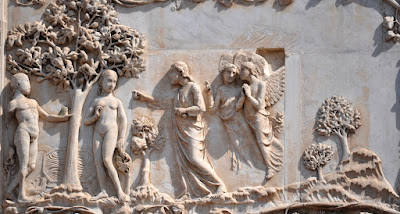On Edward Hutton's suggestion my wife and I drove to the hill town of Todi a few years ago and found it as lovely as he described it. I can still remember standing behind the Cathedral and taking in the spectacular view of the countryside.
The motor run of some thirty miles from Orvieto to Todi is one of the finest in Umbria and far more worth while than the usual approach to the little city through the Tiber valley from Perugia.
The road crosses the Paglia, the torrent that flows below Orvieto to join the Tiber to the south, by the Ponte dell’Adunata and soon begins to climb, zigzagging as it rises into the mountain, giving you wonderful views of Orvieto on its isolated Tufa bastion, over the olives and the oaks, till presently the whole of central Italy, from the Monte Sibillini in the Marches to Mount Amiata in the Senese, is spread out before you, with here Cetona, there the whole of the Cimino range with the beautiful cone of Monte Venere, and Montefiascone on its hill over the lake of Bolsena south-westward, and due south the lonely, defined form, as of a wave about to break, of Monte Soracte on the verge of the Campania. Then, as you begin to descend from these lonely and silent heights, the valley of the Tiber opens beneath you and presently you pass the picturesque village of Prodo, and a little later you catch a glimpse of Todi, most beautiful, crowning her hill. You lose her to find her again and soon, crossing the Tiber at Pontecuti with its triangular walls by a mighty great bridge of seven arches and a fine towered gate, you see the great Renaissance church—or temple is it?—of Santa Maria della Consolazione in its wide Piazzale, and climb up from it into the little ancient city where Iacopone da Todi, the author of the Stabat Mater, was born.
Todi is one of the most ancient cities in Umbria; it boasts of a foundation older than Rome. Its walls are certainly in part Etruscan, patched by the Romans, and again by the Middle Age and Renaissance, that have both left their mark, how splendidly, on the little city built on so precipitous a hill. In its day, surely, it was a place of some renown and greatness, seeing that there is so much beauty even now within its walls. And I for one find it today one of the great surprises in Umbria. … But for those who are not in a hurry Todi holds much—a great and beautiful piazza, more than one very lovely church and silence.
It is in such silence that we begin to understand those things which the world of today has forgotten, and so disastrously. Here surrounded by the Umbrian hills and valleys, serene and spacious, under the shadow of the laurels and the roses, one watches the giant cypresses, each solitary as a god, count the innumerable hours, and thus one may, perhaps, understand something of that troubadour of God who wept because “love is not loved:, who died, as it was believed, not so much conquered by his malady, though that was grave, as from an extraordinary “excess of love”, and who beheld as it were in a vision the beauty and tragedy of our world and told it in his rude but immortal verses. ***
###
***Note: Hutton provided an admiring account of the tragic life and death of Iacopone da Todi, “the greatest of the Franciscan poets, certainly the most fruitful in the vernacular, and the author of his stately, immortal Latin sequence:
Stabat Mater dolorosa…”
Edward Hutton: Assisi and Umbria Revisited, London, 1953. Pp. 148-149, 155.












